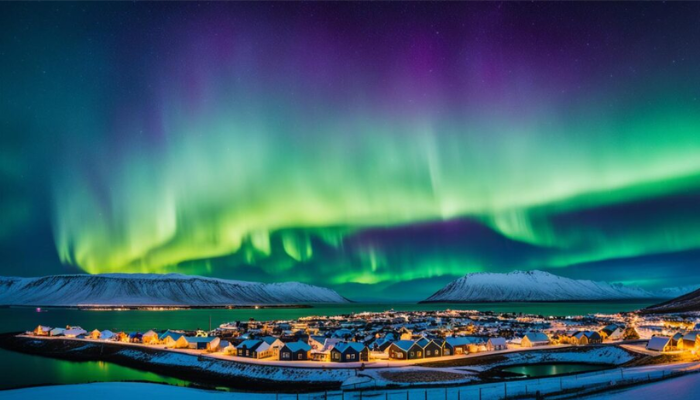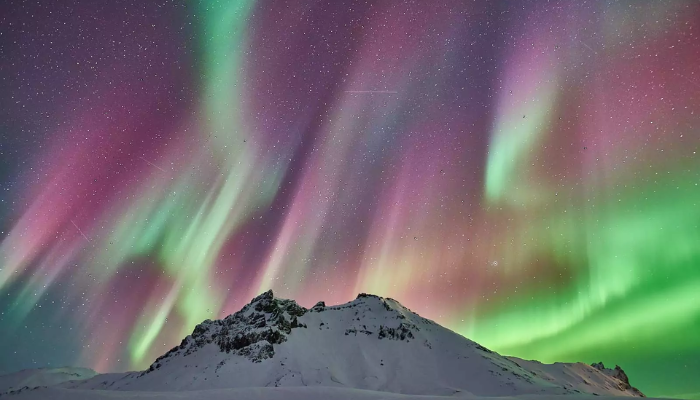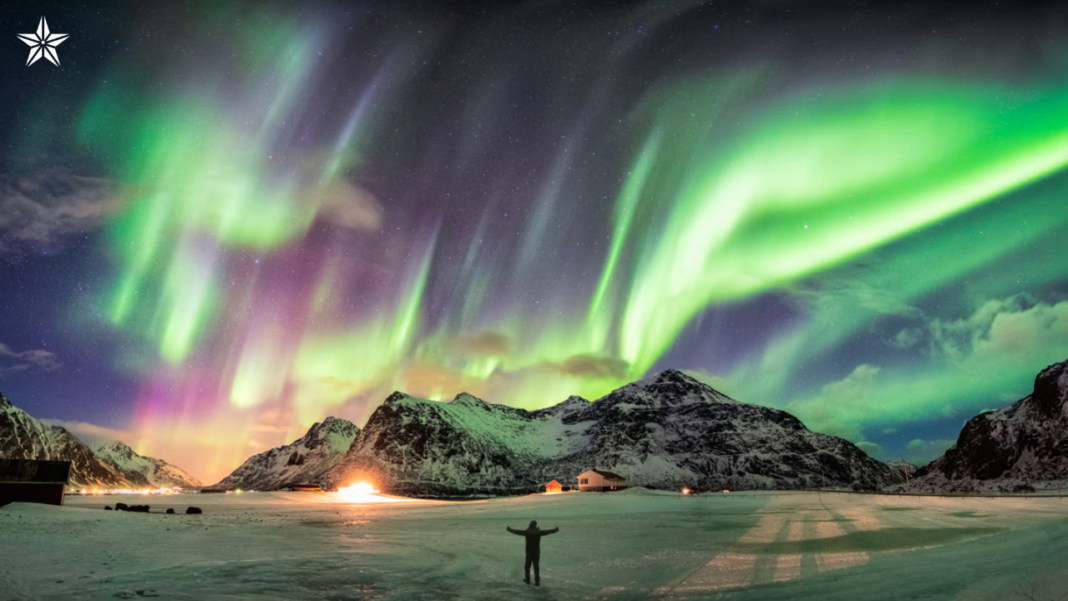In the old days, it was believed that magical creatures and gods were responsible for creating Northern Lights. That’s why it was challenging to predict the chances of viewing Aurora. But modern science has revealed facts and factors behind magical lights. The possibility of viewing dancing lights depends upon the solar activity and reaction between the electrically charged particles from the sun and the earth’s magnetic field.
Aurora experts can easily predict when and where you see the Northern Lights in Iceland. Arctic Adventures guides keep track of solar flares, and cloud covers make the Northern Lights worthwhile in your Tour. The magical lights appearing in the skies depend on factors such as solar wind speed, and the strength of speed.
The Icelandic Met Office measures solar activities, which, combined with the Cloud Forest, will give clues about where the Northern Lights are likely to be seen.
How To Read Live Northern Lights Forecast Iceland Easily?
Cloud Cover: In Reykjavík, summers are short, cool, and mostly cloudy and winters are long, cold, snowy, windy, and overcast. The temperature varies from 28°F to 57°F throughout the year and is rarely below 17°F or above 62°F.
Icelandic Landscapes Formed by Processes of Volcanism. It is characterized by rift valleys, geysers, hot springs, rhyolite mountains, columnar basalt formations, lava fields, and lunar-like craters. Table mountains were formed due to subglacial volcanism in northern and southern Iceland.
Level Of Darkness: Iceland is a country of extreme contrasts. The winters are so dark they are almost 24/7 and the summers are the reverse, giving us the midnight sun.
Here we have listed the time of sunrise, and sunset and how much daylight you’ll get each month.
The Moon:
- New Moon: 06 December 06:21
- First Quarter: 08 December 15:26
- Full Moon: 16 December 09:01
- Third Quarter: 22 December: 22:18
KP Index: Look at this scale to measure your odds of viewing the Northern Lights:
- 0-2: Very low, minimal activity. Even when this is your forecast, it is always worth going out if the sky clears.
- 2-3: Moderate activity, but plenty of chances to view. This is the most commonly issued forecast. Get moving!
- 4-6: A strong solar storm is heading our way, Get ready to behold the breathtaking display of electrifying Northern Lights
- 7-9: Extremely rare the sky will be ablaze, not even city light pollution will halt it.
Wind speed: In Iceland, the winds are measured in meters per second (m/s) and a value higher than 20 m/s-about 45 mph-is deemed unsafe. Gale-force winds over 70 mph are not rare at all during winter storms on the southern coast and especially in the Vest fjords.
Interplanetary Magnetic Field: This can be defined as the magnetic field in space between planets, which occurs inside a solar system. Data to be used comes from the DSCOVR satellite at a distance of 1.5 million km above the Earth, between the Earth and the Sun.
NOAA’S OVATION MAP
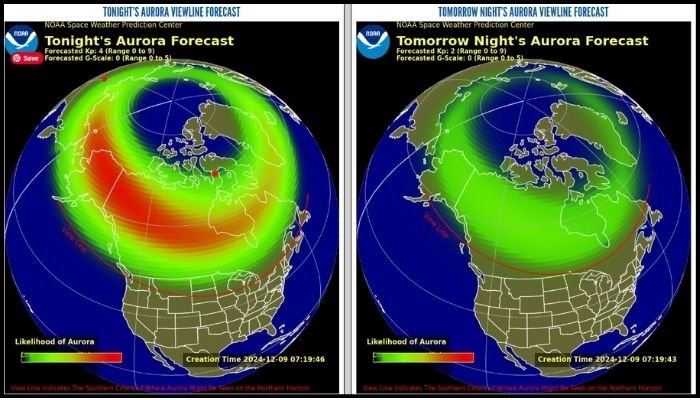
You can also view real-time aurora forecast on NOAA’s Oval Variation, Assessment, Tracking, Intensity, and Online Nowcasting (OVATION) Map. It shows the Northern and Southern hemispheres’ Northern Lights Forecast Iceland for the next 30 minutes. The map is updated every day around midnight (UTC). It is a good sign if you see thick areas of light yellow, orange, or red on the OVATION Map. Light green color indicates a lower chance of auroral activity, while the spots in yellow, orange, and red mean that chances of seeing the Northern Lights are very high.
ICELANDIC MET OFFICE
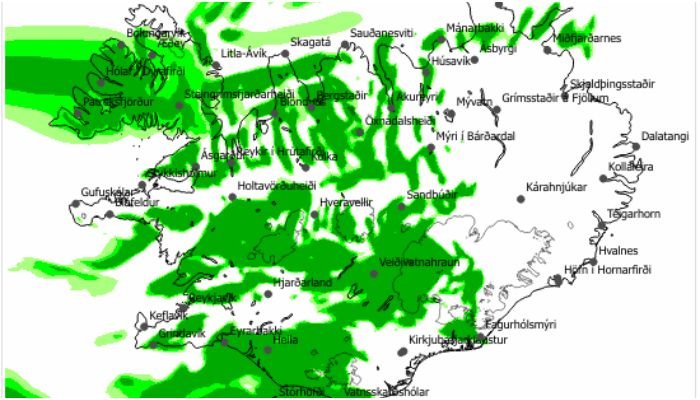
There are many tools through which you can track aurora activity, but one of the most reliable sources is the Icelandic Meteorological Office. Here, on this website, you can see the Northern Lights Forecast Iceland which gauges the level of geomagnetic activity (Kp-index). Keep an eye on the scale on the right side of the page, which goes from 0 to 9. A score of 0 means that geomagnetic activity is very low, while a score of 9 means that there is an extreme geomagnetic storm. witness the stunning dancing lights of the Aurora Borealis if your activity index (Kp number) is higher. Even at low Kp-index numbers, don’t pass up the opportunity to see the dancing lights because the scale typically doesn’t go above 8. Along with the cloud cover forecast, this map helps detect the best time to see the Northern Lights in Iceland.
How Accurate are the Northern Lights Forecast Iceland?
Be aware that a Northern Lights Forecast Iceland does not offer a guarantee about where and when the Northern Lights will appear since such a natural phenomenon is simply out of our hands.
Still, here are some guidelines to consider that might give a better chance of catching:
- Because of the long daylight hours, the auroral activity is most active between late August and early April.
- The best time to track down the aurora is during crisp winter nights when nights are long and humidity is low; hence, the sky remains mostly unclouded. In Iceland, this sharp winter begins at the end of October and continues up to mid-April.
Mark the night hours in Iceland:
- December has the longest nighttime hours, between 19 and 20 hours. The shortest night of the year is that of winter solstice with only approximately 4 hours and it, therefore, indicates 20 hours of dark.
- January and November have roughly 11 to 12-hour nights.
- February and October have a nighttime of around 9 hours
- Because Iceland is relatively close to the Arctic Circle, its summertime enjoys a near-midnight Sun–but this makes May, June, and July poor months for aurorae. You are far likelier to see an aurora if you visit during the winter than during the summer.
Best Websites and Apps to Track the Northern Lights in Iceland
- Icelandic Meteorological Office (https://en.vedur.is/)
- Aurora Service Europe (https://www.aurora-service.eu/)
- Hello, Aurora (https://hello-aurora.com/)
- Aurora Forecast Iceland (https://en.vedur.is/weather/forecasts/aurora/)
- Soft Serve News (https://www.softservenews.com/)
- SpaceWeatherLive (https://www.spaceweatherlive.com/)
Read Also:- what causes northern lights | aurora 30 minute forecast | Best Places to See Northern Lights
FAQs
Are you sure to see the Northern Lights in Iceland in December?
The best time to see the Northern Lights in Iceland is when the sky is clear and dark and the temperature is cold and dry, between mid-September and early April. You also can only see them with enough solar activity, so it is never guaranteed.
How likely is snow in Iceland in December?
December is among the coldest months of the year in Iceland. Enjoy cold mornings with abundant snowfalls—thus do not miss out on wearing a warm jacket. In Reykjavík, average temperatures stand at 0.8°C (33.4°F) with ranges between low averages of –1.6°C (29.1°F) and high averages of 3.3°C (37.9°F).
Are northern lights possible to view in Iceland?
They are typically visible above a latitude of 60 degrees north and below 60 degrees south, with the “southern lights” called the aurora australis. Iceland is the ideal location to witness the northern lights because of its latitude, roughly 64 degrees north.
Which month in Iceland is ideal for seeing the northern lights?
The best views of the Northern Lights in Iceland would be from the middle of September till the beginning of April with a clear and dark sky and cold and dry temperatures.
